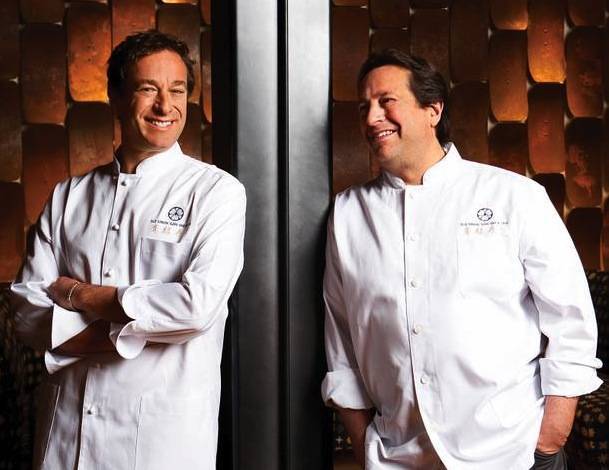Last week, New York Times contributor Adam Nagourney wrote about following the panko trail from Blue Ribbon Sushi’s original “adventurous cubbyhole of a restaurant” in Lower Manhattan to the culinary “power corridor” inside our very own Cosmopolitan. Blue Ribbon’s move to the Strip, he writes, is just one example of a great dining institution being transplanted to Las Vegas, and he asserts it’s not like opening a Hooters franchise outside of Florida. Boobs and bad hot wings cross borders pretty easily. But the Bromberg brothers’ Chawan Mushi (steamed egg custard with shrimp, unagi, shitake and spinach) and the hip understatement of their cubbyhole? Not so much.
Describing it as the “flambé effect,” Nagourney acknowledges that Vegas is perhaps the only place where ludicrous restaurant concepts and prices are not just possible but in serious demand, before getting to his real point: “After eating my way through Cosmopolitan restaurants … I was left with the disquieting feeling that these restaurants don’t always travel well, perhaps less a reflection on the food and more on the conceit of transplanting any aesthetic—be it the funky coolness of Blue Ribbon or the Melrose buzz of Comme Ça—to this carnival in the desert. What these restaurants offer instead is a reminder of what Las Vegas is ultimately about: money and the force-fed adrenaline designed to encourage people to drop their inhibitions and reach for their wallets.”
Two Weekly writers chewed on the so-called “flambé effect.”
Erin Ryan: Transplanting aesthetics is what we do, what we have needed to do to become a “place” on top of a desolate stretch of desert—at least in the eyes of the outside world. We have a Statue of Liberty and a Great Pyramid, a castle and a pirate ship. I don’t think anyone is deluded about their authenticity. More than poaching their character, we are outrageously riffing on it, boiling life’s marvels and pleasures down to one boulevard where the average person can go hog-wild. Nagourney says the Vegas Blue Ribbon "looks like a staggeringly bulked-up version of its SoHo parent." The feel may be different, and the food may be different, too, but I'm guessing the accordingly bulked-up menu is a consolation.
Brock Radke: I have eaten at Cosmo’s Blue Ribbon, and the only thing I like more than the king crab and truffle fried rice (one Las Vegas menu addition that shocks Nagourney) is the same dish substituting oxtail and bone marrow. These things are delicious; it makes no sense to question whether they are necessary or authentic or appropriate for the Vegas version of this restaurant. Restaurants expanding to Vegas undergo the same process as people visiting Vegas do—they explode into their Vegas versions, a blazing burst that allows people to joyfully do things they normally wouldn’t, and menus to spontaneously include ridiculous, over-the-top dishes that could never be created or demanded in other places. Authenticity is a foreign and confusing subject in Las Vegas. I think everyone is too busy having fun to figure that out.
ER: Part of the fun is that the big-time chefs are, as Nagourney says, "part of the show." He doesn't say that's a bad thing, but he muses on the overall inflation of the experience, and thus the price.
BR: A lot of restaurant action on the Strip these days is dictated by celebrity chefs expanding their brands in Las Vegas. Successful restaurateurs have learned you have to go big in Vegas while maintaining the brand. The executive chef at Scarpetta recently described how difficult yet absolutely essential it is to re-create signature dishes at all of Scott Conant’s restaurants, from New York to Beverly Hills to Toronto to Miami. All of those customers can and will visit Vegas, and they’ll want the spaghetti to taste the same as what they had at a different city’s Scarpetta.
ER: Unlike those cities, Las Vegas is about access. I doubt I would ever find Manhattan’s best chow without knowing a local (thankfully, I do). In Vegas, you could be from Dubai or Detroit and find everything just by walking until you hit a door. And without waiting months for a reservation or knowing the secret word for the speakeasy through the phone booth of the hot dog shop (I’ve been there, and the bacon-bourbon thingy haunts my dreams), you can indulge literally right next to the rich and famous. Does that make getting in a little less cool? Sure. But why begrudge the masses?
BR: If cities were kids in high school, New York would love to gossip about how uncool Vegas is. Vegas is not cliquey. Vegas is the popular kid that everybody likes. The Vegas experience is open to all, provided you can pay for it. What other city can say that?
ER: And why begrudge the chefs? Getting a gig at a major casino means having major resources and a drooling, captive audience for truly inspired, audacious work. Rather than trumping what comes out of the kitchen, as Nagourney says, the flambé effect gives it more elbow room. I would love to test this theory, but it stands to reason that food in restaurants transplanted here might be even better than its roots.
BR: Las Vegas has become a very important restaurant city, a must for anyone looking to establish a global dining dynasty. But it’s hard to say whether Strip restaurants serve food as good or better than the originals. I think it’s fair to say Vegas dining emphasizes the total experience and operates at a grand scale compared to almost all other cities.
ER: You might not need or appreciate the smoke and mirrors, but that’s exactly what 40 million people come here for every year. Good food? Everywhere. Good food that puts on a show? Vegas. As for Nagourney’s “force-fed adrenaline,” last time I checked, no one had to force our tourists to get crazy.
BR: It makes zero sense. Vegas visitors adrenalize when their plane descends on McCarran, or when they get that first glimpse of the Luxor’s beam driving over the desert hills. It couldn’t be forced upon anyone, even if we wanted to.
ER: Sometimes you just want an $88 chocolate treasure chest full of ice cream.









Previous Discussion: